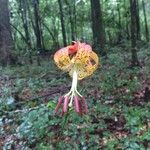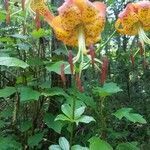Bulbs chunky, 2–3.5 × 2.5–4.4 cm, 0.6–0.9 times taller than long, 2 years’ growth evident; scales ± loose, unsegmented or rarely 1–2-segmented, longest 1.5–2.6 cm; stem roots present or rarely absent, often numerous. Stems to 1 m. Buds ± triangular in cross section. Leaves in 2–4(–5) whorls or partial whorls, 3–10(–14) leaves per whorl, ± horizontal or somewhat ascending, especially distal leaves, 3.6–11.1 × 1.5–3.8 cm, 1.8–5.1 times longer than wide; blade noticeably pale abaxially, oblanceolate, sometimes slightly or narrowly so, or occasionally obovate, texture noticeably fleshy, margins barely to strongly undulate, apex acuminate or sometimes acute, especially in distal leaves; veins and margins ± smooth abaxially. Inflorescences umbellate, 1–4-flowered. Flowers pendent, sweetly and strongly fragrant; perianth Turk’s-cap-shaped; sepals and petals reflexed 1/4–1/3 along length from base, pale green then orange proximally, burnt orange-red distally, usually with numerous fine, dark maroon spots, dull abaxially, not distinctly clawed; sepals with 2 parallel, often faint abaxial ridges, 5.7–9.7 × 1.4–2.2 cm; petals 5.7–9.2 × 1.8–2.9 cm; stamens strongly exserted; filaments parallel along most of length, then widely spreading, diverging 14°–25° from axis; anthers purple, 1–2.2 cm; pollen rust or sometimes rust-brown; pistil 5–7.6 cm; ovary 1.4–2.5 cm; style very pale, often spotted purple; pedicel 9.3–17.4 cm. Capsules often longitudinally winged, 2.4–5.6 × 1.4–2.3 cm, 1.5–3.7 times longer than wide. Seeds not counted. 2n = 24.
More
Stout, 5–12 dm; lvs in whorls of 3–7, or the uppermost 2 or 3 alternate, rather fleshy and glaucous, smooth, oblanceolate to obovate, obtuse or acute, the main ones 6–12 × 1.5–2.5 cm, the upper progressively smaller; fls 1 or 2, rarely more, nodding; tep orange-red, purple-spotted within and becoming yellow in the throat, recurved from about the middle, narrowly lanceolate, acuminate, 7–10 cm; stamens long-exserted. Dry sandy woods of the coastal plain from se. Va. to La.; also in the mts. from Va. and W.Va. southward. Aug. (L. carolinianum)


